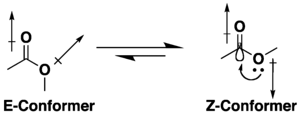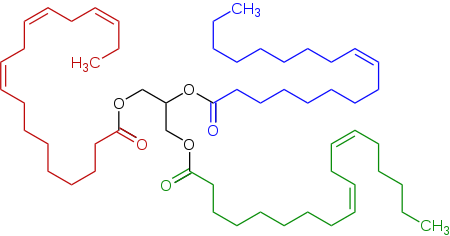Ester

Inchemistry,anesteris afunctional groupderived from anacid(organic or inorganic) in which thehydrogenatom (H) of at least oneacidichydroxylgroup (−OH) of that acid is replaced by anorganylgroup (R′). Analogues derived fromoxygenreplaced by otherchalcogensbelong to the ester category as well.[1]According to some authors, organyl derivatives of acidic hydrogen of other acids are esters as well (e.g.amides), but not according to theIUPAC.[1]
Glyceridesarefatty acid estersofglycerol;they are important in biology, being one of the main classes oflipidsand comprising the bulk ofanimal fatsandvegetable oils.Lactonesare cyclic carboxylic esters; naturally occurring lactones are mainly 5- and 6-membered ring lactones. Lactones contribute to the aroma of fruits, butter, cheese,vegetableslikeceleryand other foods.
Esters can be formed fromoxoacids(e.g. esters ofacetic acid,carbonic acid,sulfuric acid,phosphoric acid,nitric acid,xanthic acid), but also from acids that do not contain oxygen (e.g. esters ofthiocyanic acidandtrithiocarbonic acid). An example of an ester formation is thesubstitution reactionbetween acarboxylic acid(R−C(=O)−OH) and analcohol(R'−OH), forming an ester (R−C(=O)−O−R'), where R stands for any group (typically hydrogen or organyl) and R′stands for organyl group.
Organyl esters of carboxylic acids typically have a pleasant smell; those of low molecular weight are commonly used as fragrances and are found inessential oilsandpheromones.They perform as high-gradesolventsfor a broad array ofplastics,plasticizers,resins,andlacquers,[2]and are one of the largest classes of syntheticlubricantson the commercial market.[3]Polyestersare important plastics, withmonomerslinked by estermoieties.Esters of phosphoric acidform the backbone ofDNAmolecules.Esters of nitric acid,such asnitroglycerin,are known for their explosive properties.
There are compounds in which an acidic hydrogen of acids mentioned in this article are not replaced by an organyl, but by some other group. According to some authors, those compounds are esters as well, especially when the first carbon atom of the organyl group replacing acidic hydrogen, is replaced by another atom from thegroup 14 elements(Si,Ge,Sn,Pb); for example, according to them,trimethylstannyl acetate(or trimethyltin acetate)CH3COOSn(CH3)3is atrimethylstannylester ofacetic acid,anddibutyltin dilaurate(CH3(CH2)10COO)2Sn((CH2)3CH3)2is adibutylstannyleneester oflauric acid,and thePhillips catalystCrO2(OSi(OCH3)3)2is a trimethoxysilyl ester ofchromic acid(H2CrO4).[4][5]
Nomenclature
[edit]Etymology
[edit]The wordesterwas coined in 1848 by a German chemistLeopold Gmelin,[6]probably as a contraction of the GermanEssigäther,"acetic ether".
IUPAC nomenclature
[edit]The names of esters that are formed from an alcohol and an acid, are derived from the parent alcohol and the parent acid, where the latter may be organic or inorganic. Esters derived from the simplestcarboxylic acidsare commonly named according to the more traditional, so-called "trivial names"e.g. as formate, acetate, propionate, and butyrate, as opposed to the IUPAC nomenclature methanoate, ethanoate, propanoate, and butanoate. Esters derived from more complex carboxylic acids are, on the other hand, more frequently named using the systematic IUPAC name, based on the name for the acid followed by the suffix-oate.For example, the ester hexyl octanoate, also known under the trivial name hexylcaprylate,has the formulaCH3(CH2)6CO2(CH2)5CH3.

The chemical formulas of organic esters formed from carboxylic acids and alcohols usually take the formRCO2R'or RCOOR', where R and R' are theorganylparts of the carboxylic acid and the alcohol, respectively, and R can be ahydrogenin the case of esters offormic acid.For example,butyl acetate(systematically butyl ethanoate), derived frombutanolandacetic acid(systematically ethanoic acid) would be writtenCH3CO2(CH2)3CH3.Alternative presentations are common including BuOAc andCH3COO(CH2)3CH3.
Cyclic esters are calledlactones,regardless of whether they are derived from an organic or inorganic acid. One example of an organic lactone isγ-valerolactone.
Orthoesters
[edit]An uncommon class of esters are theorthoesters.One of them are the esters of orthocarboxylic acids. Those esters have the formulaRC(OR′)3,where R stands for any group (organic or inorganic) and R′stands fororganylgroup. For example,triethyl orthoformate(HC(OCH2CH3)3) is derived, in terms of its name (but not its synthesis) fromesterificationoforthoformic acid(HC(OH)3) withethanol.
Esters of inorganic acids
[edit]
Esters can also be derived from inorganic acids.
- Perchloric acidformsperchlorateesters, e.g.,methyl perchlorate(CH3−O−Cl(=O)3)
- Sulfuric acidformssulfate esters,e.g.,dimethyl sulfate((CH3−O−)2S(=O)2) andmethyl bisulfate(CH3−O−S(=O)2−OH)
- Nitric acidformsnitrate esters,e.g.methyl nitrate(CH3−O−NO2) andnitroglycerin(CH(−O−NO2)(−CH2−O−NO2)2)
- Phosphoric acidformsphosphate esters,e.g.triphenyl phosphate(O=P(−O−C6H5)3) andmethyl dihydrogen phosphate(O=P(−O−CH3)(−OH)2)
- Carbonic acidformscarbonate esters,e.g.dimethyl carbonate((CH3−O−)2C=O) and 5-memberedcyclicethylene carbonate((−CH2−O−)2C=O) (if one classifies carbonic acid as an inorganic compound)
- Trithiocarbonic acidformstrithiocarbonate esters,e.g.dimethyl trithiocarbonate((CH3−S−)2C=S) (if one classifies trithiocarbonic acid as an inorganic compound)
- Chloroformic acidformschloroformateesters, e.g.methyl chloroformate(Cl−C(=O)−O−CH3) (if one classifies chloroformic acid as an inorganic compound)
- Boric acidformsborate esters,e.g.trimethyl borate(B(−O−CH3)3)
- Chromic acidformsdi-tert-butyl chromate(((CH3)3C−O−)2Cr(=O)2)
Inorganic acids that exist astautomersform two or more types of esters.
- Thiosulfuric acidforms two types ofthiosulfateesters, e.g.O,O-dimethyl thiosulfate ((CH3−O−)2S(=O)(=S)) andO,S-dimethyl thiosulfate ((CH3−O−)(CH3−S−)S(=O)2)
- Thiocyanic acidformsthiocyanateesters, e.g.methyl thiocyanate(CH3−S−C≡N) (if one classifies thiocyanic acid as an inorganic compound), but formsisothiocyanate"esters" as well, e.g.methyl isothiocyanate(CH3−N=C=S), althoughorganylisothiocyanates are not classified as esters by theIUPAC
- Phosphorous acidforms two types of esters:phosphite esters,e.g.triethyl phosphite(P(−O−CH2CH3)3), andphosphonate esters,e.g.diethyl phosphonate(H−P(=O)(−O−CH2CH3)2)
Some inorganic acids that are unstable or elusive form stable esters.
- Sulfurous acid,which is unstable, forms stabledimethyl sulfite((CH3−O−)2S=O)
- Dicarbonic acid,which is unstable, forms stabledimethyl dicarbonate(CH3−O−C(=O)−O−C(=O)−O−CH3)
In principle, a part of metal and metalloidalkoxides,of which many hundreds are known, could be classified as esters of the corresponding acids (e.g.aluminium triethoxide(Al(OCH2CH3)3) could be classified as an ester of aluminic acid which isaluminium hydroxide,tetraethyl orthosilicate(Si(OCH2CH3)4) could be classified as an ester oforthosilicic acid,andtitanium ethoxide(Ti(OCH2CH3)4) could be classified as an ester oforthotitanic acid).
Structure and bonding
[edit]Esters derived fromcarboxylic acidsandalcoholscontain acarbonylgroup C=O, which is adivalentgroup atCatom, which gives rise to 120° C–C–O and O–C–O angles. Unlikeamides,carboxylic acid esters are structurally flexible functional groups because rotation about the C–O–C bonds has a low barrier. Their flexibility and low polarity is manifested in their physical properties; they tend to be less rigid (lower melting point) and more volatile (lower boiling point) than the correspondingamides.[7]ThepKaof the Alpha -hydrogens on esters of carboxylic acids is around 25 ( Alpha -hydrogen is a hydrogen bound to the carbon adjacent to thecarbonyl group(C=O) of carboxylate esters).[8]
Many carboxylic acid esters have the potential forconformational isomerism,but they tend to adopt anS-cis(orZ) conformation rather than theS-trans(orE) alternative, due to a combination ofhyperconjugation and dipole minimizationeffects. The preference for theZconformation is influenced by the nature of the substituents and solvent, if present.[9][10]Lactoneswith small rings are restricted to thes-trans (i.e.E) conformation due to their cyclic structure.


Physical properties and characterization
[edit]Esters derived fromcarboxylic acidsand alcohols are more polar thanethersbut less polar than alcohols. They participate inhydrogen bondsas hydrogen-bond acceptors, but cannot act as hydrogen-bond donors, unlike their parent alcohols. This ability to participate in hydrogen bonding confers some water-solubility. Because of their lack of hydrogen-bond-donating ability, esters do not self-associate. Consequently, esters are more volatile than carboxylic acids of similar molecular weight.[7]
Characterization and analysis
[edit]Esters are generally identified by gas chromatography, taking advantage of their volatility.IR spectrafor esters feature an intense sharp band in the range 1730–1750 cm−1assigned toνC=O.This peak changes depending on the functional groups attached to the carbonyl. For example, a benzene ring or double bond in conjunction with the carbonyl will bring the wavenumber down about 30 cm−1.
Applications and occurrence
[edit]Esters are widespread in nature and are widely used in industry. In nature,fatsare, in general, triesters derived fromglycerolandfatty acids.[12]Esters are responsible for the aroma of many fruits, includingapples,durians,pears,bananas,pineapples,andstrawberries.[13]Several billion kilograms ofpolyestersare produced industrially annually, important products beingpolyethylene terephthalate,acrylate esters,andcellulose acetate.[14]

Representativetriglyceridefound in a linseed oil, a triester ofglycerol(center, black) derived oflinoleic acid(bottom right, green),Alpha -linolenic acid(left, red), andoleic acid(top right, blue).
Preparation
[edit]Esterification is the general name for achemical reactionin which two reactants (typically an alcohol and an acid) form an ester as thereaction product.Esters are common in organic chemistry and biological materials, and often have a pleasant characteristic, fruity odor. This leads to their extensive use in thefragranceandflavorindustry. Ester bonds are also found in manypolymers.
Esterification of carboxylic acids with alcohols
[edit]The classic synthesis is theFischer esterification,which involves treating a carboxylic acid with an alcohol in the presence of adehydratingagent:
- RCO2H + R'OH ⇌ RCO2R' + H2O
The equilibrium constant for such reactions is about 5 for typical esters, e.g., ethyl acetate.[15]The reaction is slow in the absence of a catalyst.Sulfuric acidis a typical catalyst for this reaction. Many other acids are also used such aspolymeric sulfonic acids.Since esterification is highly reversible, the yield of the ester can be improved usingLe Chatelier's principle:
- Using the alcohol in large excess (i.e., as a solvent).
- Using a dehydrating agent: sulfuric acid not only catalyzes the reaction but sequesters water (a reaction product). Other drying agents such asmolecular sievesare also effective.
- Removal of water by physical means such asdistillationas a low-boilingazeotropewithtoluene,in conjunction with aDean-Stark apparatus.
Reagents are known that drive the dehydration of mixtures of alcohols and carboxylic acids. One example is theSteglich esterification,which is a method of forming esters under mild conditions. The method is popular inpeptide synthesis,where the substrates are sensitive to harsh conditions like high heat. DCC (dicyclohexylcarbodiimide) is used to activate the carboxylic acid to further reaction.4-Dimethylaminopyridine(DMAP) is used as an acyl-transfercatalyst.[16]
Another method for the dehydration of mixtures of alcohols and carboxylic acids is theMitsunobu reaction:
- RCO2H + R'OH + P(C6H5)3+ R2N2→ RCO2R' + OP(C6H5)3+ R2N2H2
Carboxylic acids can be esterified usingdiazomethane:
- RCO2H + CH2N2→ RCO2CH3+ N2
Using this diazomethane, mixtures of carboxylic acids can be converted to their methyl esters in near quantitative yields, e.g., for analysis bygas chromatography.The method is useful in specialized organic synthetic operations but is considered too hazardous and expensive for large-scale applications.
Esterification of carboxylic acids with epoxides
[edit]Carboxylic acids are esterified by treatment withepoxides,giving β-hydroxyesters:
- RCO2H + RCHCH2O → RCO2CH2CH(OH)R
This reaction is employed in the production ofvinyl ester resinfromacrylic acid.
Alcoholysis of acyl chlorides and acid anhydrides
[edit]Alcohols react withacyl chloridesandacid anhydridesto give esters:
- RCOCl + R'OH → RCO2R' + HCl
- (RCO)2O + R'OH → RCO2R' + RCO2H
The reactions are irreversible simplifyingwork-up.Since acyl chlorides and acid anhydrides also react with water, anhydrous conditions are preferred. The analogous acylations of amines to giveamidesare less sensitive because amines are strongernucleophilesand react more rapidly than does water. This method is employed only for laboratory-scale procedures, as it is expensive.
Alkylation of carboxylic acids and their salts
[edit]Trimethyloxonium tetrafluoroboratecan be used foresterificationof carboxylic acids under conditions where acid-catalyzed reactions are infeasible:[17]
- RCO2H + (CH3)3OBF4→ RCO2CH3+ (CH3)2O + HBF4
Although rarely employed for esterifications, carboxylate salts (often generatedin situ) react withelectrophilicalkylating agents,such asalkyl halides,to give esters.[14][18]Anion availability can inhibit this reaction, which correspondingly benefits fromphase transfer catalystsor such highly polaraprotic solventsasDMF.An additional iodide salt may, via theFinkelstein reaction,catalyze the reaction of a recalcitrant alkyl halide. Alternatively, salts of a coordinating metal, such as silver, may improve the reaction rate by easing halide elimination.
Transesterification
[edit]Transesterification,which involves changing one ester into another one, is widely practiced:
- RCO2R' + CH3OH → RCO2CH3+ R'OH
Like the hydrolysation, transesterification is catalysed by acids and bases. The reaction is widely used for degradingtriglycerides,e.g. in the production of fatty acid esters and alcohols.Poly(ethylene terephthalate)is produced by the transesterification ofdimethyl terephthalateand ethylene glycol:[14]
- n(C6H4)(CO2CH3)2+ 2nC2H4(OH)2→ [(C6H4)(CO2)2(C2H4)]n+ 2nCH3OH
A subset of transesterification is the alcoholysis ofdiketene.This reaction affords 2-ketoesters.[14]
- (CH2CO)2+ ROH → CH3C(O)CH2CO2R
Carbonylation
[edit]Alkenes undergocarboalkoxylationin the presence ofmetal carbonylcatalysts. Esters ofpropanoic acidare produced commercially by this method:
- H2C=CH2+ ROH + CO → CH3CH2CO2R
A preparation ofmethyl propionateis one illustrative example.
- H2C=CH2+ CO + CH3OH → CH3CH2CO2CH3
The carbonylation ofmethanolyieldsmethyl formate,which is the main commercial source offormic acid.The reaction is catalyzed bysodium methoxide:
- CH3OH + CO → HCO2CH3
Addition of carboxylic acids to alkenes and alkynes
[edit]Inhydroesterification,alkenes and alkynes insert into theO−Hbond of carboxylic acids.Vinyl acetateis produced industrially by the addition of acetic acid toacetylenein the presence ofzinc acetatecatalysts:[19]
- HC≡CH + CH3CO2H → CH3CO2CH=CH2
Vinyl acetatecan also be produced bypalladium-catalyzed reaction of ethylene,acetic acid,andoxygen:
- 2 H2C=CH2+ 2 CH3CO2H + O2→ 2 CH3CO2CH=CH2+ 2 H2O
Silicotungstic acidis used to manufactureethyl acetateby thealkylationofacetic acidby ethylene:
- H2C=CH2+ CH3CO2H → CH3CO2CH2CH3
From aldehydes
[edit]TheTishchenko reactioninvolvesdisproportionationof analdehydein the presence of an anhydrous base to give an ester.Catalystsare aluminium alkoxides or sodium alkoxides.Benzaldehydereacts with sodium benzyloxide (generated fromsodiumandbenzyl alcohol) to generatebenzyl benzoate.[20]The method is used in the production ofethyl acetatefromacetaldehyde.[14]
Other methods
[edit]- Favorskii rearrangementof α-haloketones in presence of base
- Baeyer–Villiger oxidationof ketones with peroxides
- Pinner reactionofnitrileswith an alcohol
- Nucleophilic abstractionof a metal–acyl complex
- Hydrolysis oforthoestersin aqueous acid
- Cellulolysis via esterification[21]
- Ozonolysisofalkenesusing awork upin the presence ofhydrochloric acidand variousalcohols.[22]
- Anodic oxidationofmethylketonesleading to methyl esters.[23]
- Interesterificationexchanges the fatty acid groups of different esters.
Reactions
[edit]Esters are less reactive than acid halides and anhydrides. As with more reactive acyl derivatives, they can react withammoniaand primary and secondary amines to give amides, although this type of reaction is not often used, since acid halides give better yields.
Transesterification
[edit]Esters can be converted to other esters in a process known astransesterification.Transesterification can be either acid- or base-catalyzed, and involves the reaction of an ester with an alcohol. Unfortunately, because the leaving group is also an alcohol, the forward and reverse reactions will often occur at similar rates. Using a large excess of thereactantalcohol or removing the leaving group alcohol (e.g. viadistillation) will drive the forward reaction towards completion, in accordance withLe Chatelier's principle.[24]
Hydrolysis and saponification
[edit]Acid-catalyzed hydrolysis of esters is also an equilibrium process – essentially the reverse of theFischer esterificationreaction. Because an alcohol (which acts as the leaving group) and water (which acts as the nucleophile) have similar pKavalues, the forward and reverse reactions compete with each other. As in transesterification, using a large excess of reactant (water) or removing one of the products (the alcohol) can promote the forward reaction.

Basic hydrolysis of esters, known assaponification,is not an equilibrium process; a full equivalent of base is consumed in the reaction, which produces one equivalent of alcohol and one equivalent of a carboxylate salt. The saponification of esters offatty acidsis an industrially important process, used in the production of soap.[24]
Esterification is a reversible reaction. Esters undergohydrolysisunder acidic and basic conditions. Under acidic conditions, the reaction is the reverse reaction of theFischer esterification.Under basic conditions,hydroxideacts as a nucleophile, while an alkoxide is the leaving group. This reaction,saponification,is the basis of soap making.
The alkoxide group may also be displaced by stronger nucleophiles such asammoniaor primary or secondaryaminesto giveamides(ammonolysis reaction):
- RCO2R' + NH2R″ → RCONHR″ + R'OH
This reaction is not usually reversible. Hydrazines and hydroxylamine can be used in place of amines. Esters can be converted toisocyanatesthrough intermediatehydroxamic acidsin theLossen rearrangement.
Sources of carbon nucleophiles, e.g.,Grignard reagentsand organolithium compounds, add readily to the carbonyl.
Reduction
[edit]Compared to ketones and aldehydes, esters arerelatively resistant to reduction.The introduction of catalytic hydrogenation in the early part of the 20th century was a breakthrough; esters of fatty acids are hydrogenated tofatty alcohols.
- RCO2R' + 2 H2→ RCH2OH + R'OH
A typical catalyst iscopper chromite.Prior to the development ofcatalytic hydrogenation,esters were reduced on a large scale using theBouveault–Blanc reduction.This method, which is largely obsolete, uses sodium in the presence of proton sources.
Especially for fine chemical syntheses,lithium aluminium hydrideis used to reduce esters to two primary alcohols. The related reagentsodium borohydrideis slow in this reaction.DIBAHreduces esters to aldehydes.[25]
Direct reduction to give the correspondingetheris difficult as the intermediatehemiacetaltends to decompose to give an alcohol and an aldehyde (which is rapidly reduced to give a second alcohol). The reaction can be achieved usingtriethylsilanewith a variety of Lewis acids.[26][27]
Claisen condensation and related reactions
[edit]Esters can undergo a variety of reactions with carbon nucleophiles. They react with an excess of a Grignard reagent to give tertiary alcohols. Esters also react readily withenolates.In theClaisen condensation,an enolate of one ester (1) will attack the carbonyl group of another ester (2) to give tetrahedral intermediate3.The intermediate collapses, forcing out an alkoxide (R'O−) and producing β-keto ester4.

Crossed Claisen condensations, in which the enolate and nucleophile are different esters, are also possible. AnintramolecularClaisen condensation is called aDieckmann condensationor Dieckmann cyclization, since it can be used to form rings. Esters can also undergo condensations with ketone and aldehyde enolates to give β-dicarbonyl compounds.[28]A specific example of this is theBaker–Venkataraman rearrangement,in which an aromaticortho-acyloxy ketone undergoes an intramolecular nucleophilic acyl substitution and subsequent rearrangement to form an aromatic β-diketone.[29]TheChan rearrangementis another example of a rearrangement resulting from an intramolecular nucleophilic acyl substitution reaction.
Other ester reactivities
[edit]Esters react with nucleophiles at the carbonyl carbon. The carbonyl is weakly electrophilic but is attacked by strong nucleophiles (amines, alkoxides, hydride sources, organolithium compounds, etc.). The C–H bonds adjacent to the carbonyl are weakly acidic but undergo deprotonation with strong bases. This process is the one that usually initiates condensation reactions. The carbonyl oxygen in esters is weakly basic, less so than the carbonyl oxygen in amides due to resonance donation of an electron pair from nitrogen in amides, but formsadducts.
As foraldehydes,the hydrogen atoms on the carbon adjacent ( "α to" ) the carboxyl group in esters are sufficiently acidic to undergo deprotonation, which in turn leads to a variety of useful reactions. Deprotonation requires relatively strong bases, such asalkoxides.Deprotonation gives a nucleophilicenolate,which can further react, e.g., theClaisen condensationand its intramolecular equivalent, theDieckmann condensation.This conversion is exploited in themalonic ester synthesis,wherein the diester ofmalonic acidreacts with an electrophile (e.g.,alkyl halide), and is subsequently decarboxylated. Another variation is theFráter–Seebach alkylation.
Other reactions
[edit]This sectionneeds additional citations forverification.(September 2024) |
- Esters can be directly converted tonitriles.[30][non-primary source needed]
- Methyl esters are often susceptible to decarboxylation in theKrapcho decarboxylation.
- Phenyl esters react to hydroxyarylketones in theFries rearrangement.
- Specific esters are functionalized with an α-hydroxyl group in theChan rearrangement.
- Esters with β-hydrogen atoms can be converted to alkenes inester pyrolysis.
- Pairs of esters are coupled to giveα-hydroxyketonesin theacyloin condensation
Protecting groups
[edit]As a class, esters serve asprotecting groupsforcarboxylic acids.Protecting a carboxylic acid is useful in peptide synthesis, to prevent self-reactions of the bifunctionalamino acids.Methyl and ethyl esters are commonly available for many amino acids; thet-butyl ester tends to be more expensive. However,t-butyl esters are particularly useful because, under strongly acidic conditions, thet-butyl esters undergo elimination to give the carboxylic acid andisobutylene,simplifying work-up.
List of ester odorants
[edit]Many esters have distinctive fruit-like odors, and many occur naturally in the essential oils of plants. This has also led to their common use in artificial flavorings and fragrances which aim to mimic those odors.
See also
[edit]- List of esters
- Amide
- Thioamide
- Carboximidate
- Carbamate
- Xanthate
- Amidine
- Cyanate
- Thiocyanate
- Selenocyanate
- Tellurocyanate
- Polyester,plasticsmade ofpolymericester
- Oligoester,a polymeric ester made of small number of estermonomers
- Polyolester,an ester that is asynthetic oilused in refrigerationcompressors
- Thioester
- Transesterification
- Ether lipid,an ester that is alipidand anether
- Acylal((R1−C(=O)−O−)(R2−C(=O)−O−)CH−R3)
- Ortho ester,an ester of anortho acid(e.g. esters oforthocarboxylic acids,orthocarbonic acid,orthosilicic acid,orthotelluric acid,orthophosphoric acid,orthoboric acid,...)
- Depside,a polymeric ester, a type ofpolyphenoliccompound composed of two or more monocyclicaromaticunits linked by an ester group
- Depsipeptide,a type of ester that is apeptidein which one or more of itsamidegroups (−C(=O)−NH−) are replaced by the corresponding ester groups (−C(=O)−O−)[31]
- Glyceride((R1−C(=O)−O−CH2−)(R2−C(=O)−O−CH2−)(R3−C(=O)−O−)CH), an ester offatty acidsandglycerol
- Lactone,a cyclic carboxylic ester
- Lactide,a type of lactone ester
- Vitamin C(ascorbic acid), a lactone ester, anessential nutrientfor humans and other animals
- Phthalide,a type of lactone ester
- Coumarin,a type of lactone ester
- Macrolide,a class of natural esters that consist of a largemacrocycliclactone ring to which one or moredeoxy sugarsmay be attached
- Formate
- Chloroformate
References
[edit]- ^abIUPAC,Compendium of Chemical Terminology,2nd ed. (the "Gold Book" ) (1997). Online corrected version: (2006–) "esters".doi:10.1351/goldbook.E02219
- ^Cameron Wright (1986).A worker's guide to solvent hazards.The Group. p. 48.ISBN9780969054542.
- ^E. Richard Booser (21 December 1993).CRC Handbook of Lubrication and Tribology, Volume III: Monitoring, Materials, Synthetic Lubricants, and Applications.CRC. p. 237.ISBN978-1-4200-5045-5.
- ^"Acetoxytrimethyltin".
- ^"Trimethyltin acetate | C5H12O2Sn | ChemSpider".
- ^Leopold Gmelin,Handbuch der Chemie,vol. 4:Handbuch der organischen Chemie(vol. 1) (Heidelberg, Baden (Germany): Karl Winter, 1848),page 182.
Original text:
Translation:b. Ester oder sauerstoffsäure Aetherarten.
Ethers du troisième genre.
Viele mineralische und organische Sauerstoffsäuren treten mit einer Alkohol-Art unter Ausscheidung von Wasser zu neutralen flüchtigen ätherischen Verbindungen zusammen, welche man als gepaarte Verbindungen von Alkohol und Säuren-Wasser oder, nach der Radicaltheorie, als Salze betrachten kann, in welchen eine Säure mit einem Aether verbunden ist.b. Ester or oxy-acid ethers.
Ethers of the third type.
Many mineral and organic acids containing oxygen combine with an alcohol upon elimination of water to [form] neutral, volatile ether compounds, which one can view as coupled compounds of alcohol and acid-water, or, according to the theory of radicals, as salts in which an acid is bonded with an ether. - ^abMarch, J.Advanced Organic Chemistry4th Ed. J. Wiley and Sons, 1992: New York.ISBN0-471-60180-2.
- ^"Chemistry of Enols and Enolates – Acidity of Alpha -hydrogens".13 February 2011.
- ^Diwakar M. Pawar; Abdelnaser A. Khalil; Denise R. Hooks; Kenneth Collins; Tijuana Elliott; Jefforey Stafford; Lucille Smith; Eric A. Noe (1998). "EandZConformations of Esters, Thiol Esters, and Amides ".Journal of the American Chemical Society.120(9): 2108–2112.doi:10.1021/ja9723848.
- ^Christophe Dugave; Luc Demange (2003). "Cis−Trans Isomerization of Organic Molecules and Biomolecules: Implications and Applications".Chemical Reviews.103(7): 2475–2932.doi:10.1021/cr0104375.PMID12848578.
- ^A. A. Yakovenko; J. H. Gallegos; M. Yu. Antipin; A. Masunov; T. V. Timofeeva (2011). "Crystal Morphology as an Evidence of Supramolecular Organization in Adducts of 1,2-Bis(chloromercurio)tetrafluorobenzene with Organic Esters".Crystal Growth & Design.11(9): 3964–3978.doi:10.1021/cg200547k.
- ^Isolation of triglyceride from nutmeg: G. D. Beal "Trimyristen" Organic Syntheses, Coll. Vol. 1, p.538 (1941).Link
- ^McGee, Harold.On Food and Cooking.2003, Scribner, New York.
- ^abcdeRiemenschneider, Wilhelm; Bolt, Hermann M. "Esters, Organic".Ullmann's Encyclopedia of Industrial Chemistry.Weinheim: Wiley-VCH.doi:10.1002/14356007.a09_565.pub2.ISBN978-3527306732.
- ^Williams, Roger J.; Gabriel, Alton; Andrews, Roy C. (1928). "The Relation Between the Hydrolysis Equilibrium Constant of Esters and the Strengths of the Corresponding Acids".Journal of the American Chemical Society.50(5): 1267–1271.doi:10.1021/ja01392a005.
- ^B. Neises & W. Steglich."Esterification of Carboxylic Acids with Dicyclohexylcarbodiimide/4-Dimethylaminopyridine:tert-Butyl ethyl fumarate ".Organic Syntheses;Collected Volumes,vol. 7, p. 93.
- ^Raber, Douglas J.; Gariano, Jr, Patrick; Brod, Albert O.; Gariano, Anne L.; Guida, Wayne C. (1977). "Esterification of Carboxylic Acids with Trialkyloxonium Salts: Ethyl and Methyl 4-Acetoxybenzoates".Organic Syntheses.56:59.doi:10.15227/orgsyn.056.0059.
- ^Matsumoto, Kouichi; Shimazaki, Hayato; Miyamoto, Yu; Shimada, Kazuaki; Haga, Fumi; Yamada, Yuki; Miyazawa, Hirotsugu; Nishiwaki, Keiji; Kashimura, Shigenori (2014)."Simple and Convenient Synthesis of Esters from Carboxylic Acids and Alkyl Halides Using Tetrabutylammonium Fluoride".Journal of Oleo Science.63(5): 539–544.doi:10.5650/jos.ess13199.ISSN1345-8957.PMID24770480.
- ^Bienewald, Frank; Leibold, Edgar; Tužina, Pavel; Roscher, Günter (2019). "Vinyl Esters".Ullmann's Encyclopedia of Industrial Chemistry.Weinheim: Wiley-VCH. pp. 1–16.doi:10.1002/14356007.a27_419.pub2.ISBN9783527303854.
- ^Kamm, O.; Kamm, W. F. (1922)."Benzyl benzoate".Organic Syntheses.2:5.doi:10.15227/orgsyn.002.0005;Collected Volumes,vol. 1, p. 104.
- ^Ignatyev, Igor; Charlie Van Doorslaer; Pascal G.N. Mertens; Koen Binnemans; Dirk. E. de Vos (2011)."Synthesis of glucose esters from cellulose in ionic liquids".Holzforschung.66(4): 417–425.doi:10.1515/hf.2011.161.S2CID101737591.
- ^Neumeister, Joachim; Keul, Helmut; Pratap Saxena, Mahendra; Griesbaum, Karl (1978). "Ozone Cleavage of Olefins with Formation of Ester Fragments".Angewandte Chemie International Edition in English.17(12): 939–940.doi:10.1002/anie.197809392.
- ^Makhova, Irina V.; Elinson, Michail N.; Nikishin, Gennady I. (1991). "Electrochemical oxidation of ketones in methanol in the presence of alkali metal bromides".Tetrahedron.47(4–5): 895–905.doi:10.1016/S0040-4020(01)87078-2.
- ^abWade 2010, pp. 1005–1009.
- ^W. Reusch."Carboxyl Derivative Reactivity".Virtual Textbook of Organic Chemistry.Archived fromthe originalon 2016-05-16.
- ^Yato, Michihisa; Homma, Koichi; Ishida, Akihiko (June 2001). "Reduction of carboxylic esters to ethers with triethyl silane in the combined use of titanium tetrachloride and trimethylsilyl trifluoromethanesulfonate".Tetrahedron.57(25): 5353–5359.doi:10.1016/S0040-4020(01)00420-3.
- ^Sakai, Norio; Moriya, Toshimitsu; Konakahara, Takeo (July 2007). "An Efficient One-Pot Synthesis of Unsymmetrical Ethers: A Directly Reductive Deoxygenation of Esters Using an InBr3/Et3SiH Catalytic System".The Journal of Organic Chemistry.72(15): 5920–5922.doi:10.1021/jo070814z.PMID17602594.
- ^Carey 2006, pp. 919–924.
- ^Kürti and Czakó 2005, p. 30.
- ^Wood, J. L.; Khatri, N. A.; Weinreb, S. M. (1979). "A direct conversion of esters to nitriles".Tetrahedron Letters.20(51): 4907.doi:10.1016/S0040-4039(01)86746-0.
- ^IUPAC,Compendium of Chemical Terminology,2nd ed. (the "Gold Book" ) (1997). Online corrected version: (2006–) "depsipeptides".doi:10.1351/goldbook.D01604










